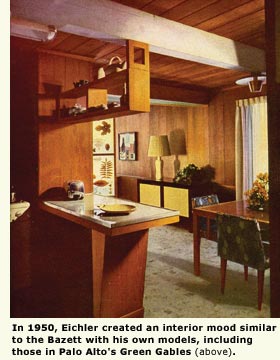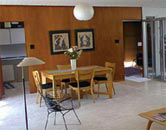Your Eichler's Mahogany Paneling - Page 2
As building codes changed, Eichler's drywall finishing techniques evolved with the technology. The earlier 'skip trowel' finish was later replaced by the smooth-wall finish (including sheet rock) in some of his later developments, beginning in the mid-1960s. While Cooke claims this finish remains the most popular among his Eichler clients today, he still encounters those requesting wood paneling.
However, today, most building codes and fire-safety provisions do not allow the installation of stand-alone wood paneling. Once original wood paneling is removed, most codes require homeowners to replace those panels (or at least line them) with fire-resistant products such as drywall.
There are other disadvantages to maintaining wood paneling on interior walls. Paneling darkens with age, and as a result, some homeowners find that such paneling makes their rooms also "feel dark." Others experience difficulty selecting furniture and artwork for a wood-paneled room.
What's in the Future
|
So what is an Eichler owner to do? Is there a way to balance the desire for a nostalgic return to better times and Eichler's purity while reckoning with paneling's dark disadvantages? And what are the wisest choices?
When Jerry Escobar and his family moved into their San Jose Eichler three years ago, none of the wood paneling existed in its original condition; all of it had been painted or whitewashed. So, Escobar decided to restore a portion of his interior walls. "If we had bought the house in original condition, we would have kept the paneling," Escobar says. "But it was not, so we selected certain walls to become focal points. On these walls we wanted mahogany. We believed that this would provide the warmth that some of today's modernist homes lack."

According to Escobar, finding the quarter-round base trim can be challenging, so he re-used his originals. While one can purchase new quarter-rounds, Escobar found that today their dimensions are larger than the originals and don't have quite the same look.
Some homeowners prefer to restore their original paneling, while others opt to dramatically brighten the interior with light-colored paint. Lou Palladino, owner of Palladino Painting, Inc., observes that 'what to do with the paneling?' is a question that inevitably comes up with his Eichler clients as they begin to upgrade and remodel their homes. But many of his customers are reluctant to paint their paneling, preferring to go the restoration route.
If the paneling is salvageable, Palladino will prepare it with a cleaning and a light sanding, being careful not to wear through the thin veneer. He then uses toned polyurethane to restore the color and add richness. Palladino likes using a urethane with color in it because, he says, "it allows us to modify the look by blending and softening the appearance of the damaged areas."
Painting over paneling is also quite common today, says Palladino, since some Eichler owners simply do not care for the dark look of the wood walls. "For painting, we prepare the paneling by sanding, cleaning, and sealing with an oil-based primer," he says. "If the homeowner likes, we can also conceal the vertical wood joints by taping them. To do this, we fill the joints with joint compound, then lay a thin film of the compound over the joint, and then imbed joint tape in it. After that, the tape is covered with more joint compound, and the surface is sanded out to achieve a smooth finish."





